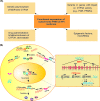Pharmacogenetics and drug-induced nephrotoxicity in renal transplant recipients
- PMID: 25901296
- PMCID: PMC4401167
- DOI: 10.15171/bi.2015.12
Pharmacogenetics and drug-induced nephrotoxicity in renal transplant recipients
Abstract
Introduction: The advent of calcineurin inhibitors (CNIs), as the leading immunosuppressive agents, not only has revolutionized the transplant medicine but also made it a better therapeutic intervention that guarantees the graft outcome and improves the survival rate of patients. However, genetic polymorphism(s) in the CNIs metabolic substrates genes (CYP3A4, CYP3A5) and their transporter such as P-glycoprotein (P-gp) can influence the CNIs metabolism and elicit some possible systemic and intra-renal exposures to drugs and/or metabolites with differential risk of nephrotoxicity, jeopardizing the transplantation.
Methods: In the current study, we review the recent literatures to evaluate the effects of genetic polymorphisms of the genes involved in development of chronic calcineurin nephrotoxicity and progression of chronic allograft dysfunction (CAD) providing an extensive overview on their clinical impacts.
Results: Identifying the inherited genetic basis for the inter-individual differences in terms of drug responses and determining the risk of calcineurin-mediated nephrotoxicity and CAD allow optimized personalized administration of these agents whith minimal adverse effects.
Conclusion: Pharmacogenetics characteristics of CYP isoforms (CYP3A) and efflux transporters (P-gp and MRP), involved in metabolism and extracellular transportation of the immunosuppressive CNIs, can be of pivotal information in the pharmacotherapy of the renal-transplant recipients. Such information can be used for the successes clinical interventions to attain an improved drug administration strategy with reduced rates of rejection and toxicity.
Keywords: Calcineurin inhibitors; Cytochrome P450; Immunosuppressive agents; Nephrotoxicity; Pharmacogenetics; Renal transplantation.
Similar articles
-
Effect of CYP3A and ABCB1 single nucleotide polymorphisms on the pharmacokinetics and pharmacodynamics of calcineurin inhibitors: Part II.Clin Pharmacokinet. 2010 Apr;49(4):207-21. doi: 10.2165/11317550-000000000-00000. Clin Pharmacokinet. 2010. PMID: 20214406 Review.
-
Treatment strategies in pediatric solid organ transplant recipients with calcineurin inhibitor-induced nephrotoxicity.Pediatr Transplant. 2006 Sep;10(6):721-9. doi: 10.1111/j.1399-3046.2006.00577.x. Pediatr Transplant. 2006. PMID: 16911497 Review.
-
The pharmacogenetics of immunosuppression for organ transplantation: a route to individualization of drug administration.Am J Pharmacogenomics. 2003;3(5):291-301. doi: 10.2165/00129785-200303050-00001. Am J Pharmacogenomics. 2003. PMID: 14575518 Review.
-
Pharmacogenetics in immunosuppressants: impact on dose requirement of calcineurin inhibitors in renal and liver pediatric transplant recipients.Curr Opin Organ Transplant. 2010 Oct;15(5):601-7. doi: 10.1097/MOT.0b013e32833de1d0. Curr Opin Organ Transplant. 2010. PMID: 20720493 Review.
-
The role of pharmacogenetics in the disposition of and response to tacrolimus in solid organ transplantation.Clin Pharmacokinet. 2014 Feb;53(2):123-39. doi: 10.1007/s40262-013-0120-3. Clin Pharmacokinet. 2014. PMID: 24249597 Review.
Cited by
-
Update on the reciprocal interference between immunosuppressive therapy and gut microbiota after kidney transplantation.World J Transplant. 2024 Mar 18;14(1):90194. doi: 10.5500/wjt.v14.i1.90194. World J Transplant. 2024. PMID: 38576749 Free PMC article. Review.
-
Polymorphisms associated with everolimus pharmacokinetics, toxicity and survival in metastatic breast cancer.PLoS One. 2017 Jul 20;12(7):e0180192. doi: 10.1371/journal.pone.0180192. eCollection 2017. PLoS One. 2017. PMID: 28727815 Free PMC article.
-
A circulating exosomal microRNA panel as a novel biomarker for monitoring post-transplant renal graft function.J Cell Mol Med. 2020 Oct;24(20):12154-12163. doi: 10.1111/jcmm.15861. Epub 2020 Sep 11. J Cell Mol Med. 2020. PMID: 32918330 Free PMC article.
-
Organ transplantation and gut microbiota: current reviews and future challenges.Am J Transl Res. 2018 Nov 15;10(11):3330-3344. eCollection 2018. Am J Transl Res. 2018. PMID: 30662590 Free PMC article. Review.
-
Differential expression of circulating miR-21, miR-142-3p and miR-155 in renal transplant recipients with impaired graft function.Int Urol Nephrol. 2017 Sep;49(9):1681-1689. doi: 10.1007/s11255-017-1602-2. Epub 2017 Apr 28. Int Urol Nephrol. 2017. PMID: 28455659
References
-
- Fredericks S, Holt DW, MacPhee IA. The pharmacogenetics of immunosuppression for organ transplantation: a route to individualization of drug administration. Am J Pharmacogenomics. 2003;3:291–301. - PubMed
-
- Pazik J, Oldak M, Dabrowski M, Lewandowski Z, Sitarek E, Podgorska M. et al. Association of UDP-glucuronosyltransferase 1A9 (UGT1A9) gene polymorphism with kidney allograft function. Ann Transplant. 2011;16:69–73. - PubMed
-
- Grenda R, Prokurat S, Ciechanowicz A, Piatosa B, Kalicinski P. Evaluation of the genetic background of standard-immunosuppressant-related toxicity in a cohort of 200 paediatric renal allograft recipients--a retrospective study. Ann Transplant. 2009;14:18–24. - PubMed
-
- Mascarell L, Truffa-Bachi P. New aspects of cyclosporin a mode of action: from gene silencing to gene up-regulation. Mini Rev Med Chem. 2003;3:205–14. - PubMed
Publication types
LinkOut - more resources
Full Text Sources
Other Literature Sources
Miscellaneous


